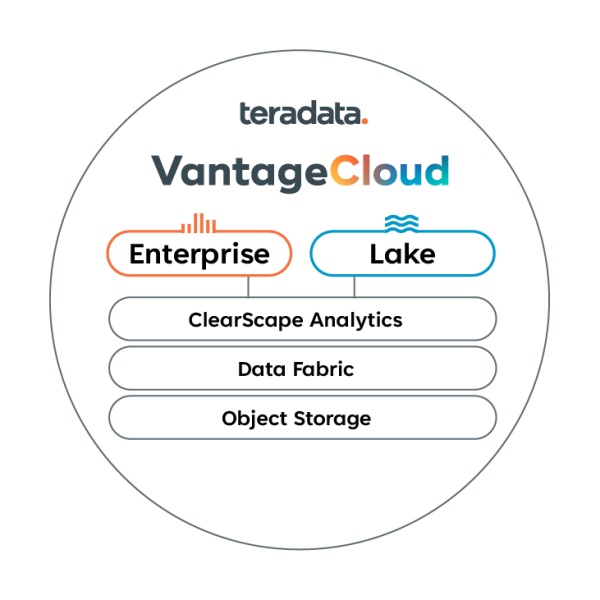Teradata last Monday unveiled two new products: the cloud-native VantageCloud Lake, a new version of its data lake platform – renamed Vantage Enterprise, and ClearScape Analytics, an expanded and rebranded version of its analytics platform.
The new pair of cloud-native offerings is designed to extend the reach of the database and analytics giant beyond its traditional customer base, while taking one its cloud-native competitors. Together, the two are a part of the Teradata VantageCloud offering, a complete cloud analytics and data platform - and they will enable the enterprise ecosystem with capabilities of data storage, processing, and analytics.

Born in the cloud
Built on entirely new, cloud-native architecture, VantageCloud Lake is designed to leverage automatically elastic, fully isolated multi-compute clusters, as well as separate but highly optimised object storage, such as Amazon Simple Storage Service (Amazon S3), so that customers can quickly and easily respond and adapt to changing business needs.
VantageCloud Lake is designed to rapidly accelerate business outcomes for virtually any use case, including smaller ad hoc, exploratory, and departmental workloads.

“VantageCloud Lake is the result of a multi-year journey to create a new paradigm for data and analytics – one where superior performance, agility, and value all go hand-in-hand,” said Hillary Ashton, chief product officer at Teradata. “VantageCloud Enterprise – our established Vantage in the cloud offering – is the recognised price performance leader in the market. Teradata VantageCloud Lake offers all of those same benefits in a package that is appealing to diverse functions and roles, opening up an entirely new market segment for us.”
Companies today are using Teradata to run business critical workloads with strict service level agreements (SLAs) to meet core business needs, such as an airline having a reservation system up and running 24/7.
As such, these workloads are highly governed by IT and sheltered from potential interference. The result is that establishing new projects, like a mobile customer engagement application, can be very difficult to get started – especially new analytics projects that can consume unpredictable resources and put SLAs at risk.
Departmental workloads and exploratory data science projects are often delayed or rejected, as enterprise workloads are prioritised. These new projects then drive the adoption of shadow systems on alternate technologies, but as these shadow systems proliferate, so do the costs and governance challenges for the organisation.
With the introduction of Teradata VantageCloud Lake, organisations have a greater ability to innovate by quickly spinning up ad hoc, exploratory, and departmental workloads, for example, leveraging open, connected data and gaining easy access to all of the other benefits Teradata offers with its flagship product.
“We now support all analytic workload needs at every level in the organisation, enabling companies to be more nimble, experimental, and innovative in an easy-to-use solution without losing the governance and cost visibility that Teradata is known for,” said Ashton.
Driving analytical innovation at scale
Furthermore, VantageCloud Lake provides both workload management and workload isolation at scale. It ensures that independent compute clusters only automatically scale, when necessary, based on actual consumption of system resources (rather than simply based on query or user counts).
VantageCloud Lake has policy-driven scaling, allowing organizations to place guardrails on specific workloads to facilitate budget management. This flexibility is supported by comprehensive reporting that also showcases full financial visibility of each workload. Together, these differentiated capabilities (less frequent scaling, optional guardrails, and comprehensive reporting) make it easier for companies to balance the needs of business autonomy with fiscal governance.

If the size of the project or the numbers of projects grow, the solution can also scale to massive size. In fact, earlier this year, Teradata executed a 1012 node scale test on Amazon Web Services (AWS) to illustrate the scale, performance, and resilience of the new architecture.
Teradata worked with AWS to support Amazon Elastic Compute Cloud (Amazon EC2), Amazon Elastic Block Store (EBS) and Amazon S3. For example, customers can reach high scalability by decoupling and independently scaling compute and storage using AWS Auto Scaling, to give mutual Teradata and AWS customers additional flexibility.
“Scale is so critical for our customer base as data volumes continue to expand and critical enterprise workloads make their way to the cloud. AWS customers can use this solution to meet their analytics needs at every level of their organization,” said Ruba Borno, vice president for worldwide channels & alliances at AWS.
Operationalising AI and ML
Simultaneous to the launch of VantageCloud Lake, Teradata also introduced new features of its expanded analytics platform – now rebranded ClearScape Analytics, which delivers more than 50 new in-database time series and ML functions, and integrated ModelOps that are designed to rapidly operationalise AI/ML initiatives.
This new functionality – in combination with the launch of Teradata VantageCloud Lake is intended to provide customers the ability to activate massive amounts of data and solve complex business challenges with a robust library of open and connected analytics tools designed to provide autonomy, ease of access, and real-time insights.
“Data is only as valuable as its ability to be synthesized for actionable, real-world insights that drive better outcomes,” said Ashton. “Over its 40+ year history, we have been laser-focused on helping customers extract the most value from their data with consistently high performance, unmatched scalability, and a trove of analytic functionality.”
She added: “With the launch of Teradata VantageCloud Lake and the availability of ClearScape Analytics across the VantageCloud platform, we are continuing the tradition of listening to customers and helping them accelerate their digital transformations by providing a data platform that is born in the cloud with end-to-end support for advanced analytics across the cloud ecosystem.”
ClearScape Analytics’ new in-database time series functions span the entire analytics lifecycle, from data transformation and statistical hypothesis tests, to feature engineering and machine learning modelling.
Because these functions are built into the database, they are highly performant and require limited data movement. This can represent significant cost and friction reduction, particularly when a company wants to apply time-series analytics on large volumes of data such as millions of products or billions of sensors.
When the results of these analytic functions, such as forecasts, are stored inside the database, organisations can easily integrate that with other data. For example, a manufacturer could integrate a sensor anomaly detection score with the location of a machine and find out the location of a predicted failure, or a global retailer could integrate forecast results with price to predict revenue.
Additionally, with ClearScape Analytics, complex machine learning functions can be easily integrated into analytic pipelines – a collection of related operations that go from data preparation all the way through modelling and deployment – but packaged together to address specific problems.

For example, a classification pipeline can be tweaked and tuned specifically for fraud detection that might go into a financial application, or a time series pipeline might be used for demand forecasting in a retail or manufacturing scenario.
And with ModelOps embedded into ClearScape Analytics, organisations will be able to quickly scale AI/ML initiatives to unlock the full value of their investment while mitigating risk. ModelOps plays a key role in model governance and risk management, which will become increasingly important as companies send more models into production.
“Teradata’s comprehensive analytics offering has long helped organisations make the most use of their data, regardless of where it sits within an organization,” said Dan Vesset, group vice president, analytics and information management market research at IDC. “Teradata’s continued investment in this area with ClearScape Analytics underscores its commitment to help customers operationalise analytics and AI/ML at scale to solve the most pressing business challenges – from real-time customer personalization to supply chain optimization —across all industries.”





